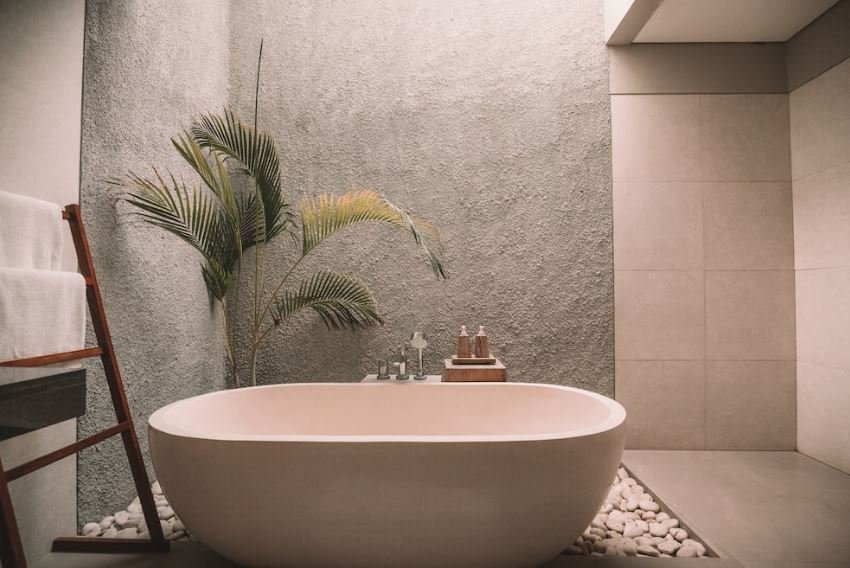Bathroom
How to Maintain Your Porcelain Bathtub?

Anyone with a porcelain bathtub could tell you that cleaning is the most challenging part of owning one. Whether you are talking about a bathtub made of cast iron and coated with porcelain, or a new model with pure porcelain, the key lies in regular cleaning to keep it clean.
When you find an old porcelain tub in the market, it is not uncommon to find dingy marks from years of use. Even when you get a new one on the market, it won’t take long before you start seeing any signs of damage.
Here are some of the basics of porcelain tubs and what you need to know to take care of them.
[lwptoc]
Before Cleaning
You need to clean your bathtub regularly. However, there are a few cleaning methods that you want to avoid. The enamel in your porcelain bathtub is applied like glass and then fused to a cast iron structure, leaving it prone to scratches.
You should think of cleaning your porcelain bathtub the same way you approach a glass window that can be scratched. Therefore, the materials used for cleaning should be chosen with care.
Harsh cleaning materials can affect your porcelain bathtub by eating away the enamel. Avoid acidic substances as they can start to wear the surface after a long period of use. Even rough cloths can scratch the underneath surface.
Be careful when using anything to do with dyes in or around your bathtub, as they could leave traces of their color. In unavoidable situations, like when you are using hair dyes on your porcelain bathtub, be sure to use running tap water to wash the color off. Some bathtubs may even get stained if you let hard water rest for long.
Here are some materials to avoid in or around your bathtub.
- Steel wool
- Scouring powder
- Some abrasive cleaners like ammonia and Chlorine
These cleaning tools affect the porcelain finish and could make your porcelain look worse than it did when you started. Chlorine bleaches should be avoided because they cause oxidation, making your tub look dull. Also, avoid these cleaners if you don’t know the history of your bathtub, as mixing chemicals could be dangerous.
Regular Cleaning
Regular cleaning should be part of your schedule if you want to maintain your porcelain bathtub. If you clean your shower regularly, you won’t have so much work to do to get soap scum off the surface.
If possible, make a habit of cleaning your porcelain bathtub weekly. This will allow you to make a light clean which is simple.
Most importantly, you need to find a safe cleaner for your tub. You can choose from a wide range of cleaners available at the store and make your own cleaner at home.
If you choose to purchase from the store, you can look at those cleaners that are clearly marked as safe for porcelain enamel. For a homemade cleaner, you can mix a few tablespoons of dishwashing soap with hot water. Baking soda mixed with hot water can also be a good cleaner for your bathtub. You can use anything with a grease-cutting ability mixed with hot water to make a homemade cleaner.
Next, use a soft rag or sponge, dip it in the mixture and then use it to clean your tub gently. Please don’t use any abrasive sponge as it could cause scratches. Thoroughly rinse the cleaner with fresh water, after which you are required to wipe down the surfaces to remove any water.
Targeted Cleaning
Stubborn stains are not uncommon on porcelain surfaces. You can use acidic characters in substances such as lemon juice as it is less abrasive. You can use these cleaners directly on the surfaces and dilute them with water to clean your bathtub.
You will still need to use a soft sponge when cleaning specific areas of your bathtub, as this would avoid any scratches. After the mixture has sat in the tub for a while, you should rinse the acidic cleaner thoroughly.
Rust Spots
You could worry about rust stains if you are dealing with an old or neglected bathtub. One method uses a paste from a combination of vinegar and baking soda. However, baking soda should be diluted as it is abrasive. Apply your paste in a circular motion around the rust stain and let it settle for a while before rinsing it off.
The acidity of lemon can help remove stubborn stains associated with rust. Cut a piece of lemon and soak it in a tray of salt. Apply the combination to the rust stain and rinse it off thoroughly, after which you use a dry piece of cloth to dry any water.
Conclusion
Porcelain surfaces are known for their durability and shine. However, it will take extra effort to maintain them. The good news is that a variety of porcelain cleaners are available at your local store. You could also consider using a homemade porcelain cleaner from grease-cutting agents.
Most importantly, you need to take extra caution so that you don’t leave scratches on your porcelain tub.
-

 Celebrity4 weeks ago
Celebrity4 weeks agoIs YNW Melly Out Of Jail? What Is The YNW Melly Release Date, Career, Early Life, And More
-

 Sports4 weeks ago
Sports4 weeks agoMore Than Just a Game: How College Sports Can Shape Your Future
-

 Tech3 weeks ago
Tech3 weeks agoAI Software: Transforming the Future of Technology
-

 Tech3 weeks ago
Tech3 weeks agoAll About Com. Dti. Folder Launcher: Features, Benefits, Tips, And More













